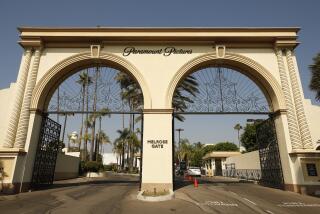Restructured Company Looks to Diversify : Navistar Now Set to Reap Profits
- Share via
CHICAGO — Cyrus McCormick wouldn’t recognize the company he spawned by inventing the reaper back in 1831.
That company, International Harvester Co., doesn’t make reapers or any other kind of farm equipment anymore. Trucks and diesel engines are its business now. And it no longer bears the name International Harvester: With help from a high-priced corporate image consulting outfit, the company has been rechristened Navistar International Corp.
There’s one other piece of history that the company has shaken off, something from its more recent past. After losing more than $3 billion over six years, and narrowly avoiding bankruptcy, the company inched back into the black last year, albeit just barely, turning a $2-million profit in fiscal 1986.
Having exorcised the demons of the past, Navistar’s leaders are allowing themselves to peek toward the future. Backed by a financial restructuring recently approved by shareholders, the company is on the prowl for an acquisition that will allow it to diversify and expand after years of contraction.
“We now have shifted from a focus on survival to a focus on profitable growth for the remainder of the 1980s and beyond,” outgoing Chairman Donald D. Lennox told shareholders at the company’s annual meeting last month.
Lennox, who retired in early April, is credited with saving the company from bankruptcy by making tough decisions to close plants, sell the farm-equipment division and restructure its finances. “In eight years, I have seen (the company) at its worst, tottering on the edge of bankruptcy,” he told shareholders in his valedictory address. “I wouldn’t want to go through it again.”
Navistar’s new chairman is another veteran of the company’s hard times, James C. Cotting. The 53-year-old Cotting, formerly vice chairman and chief financial officer, handled the difficult negotiations with lenders during the company’s darkest times, in 1982 and 1983, and was architect of the restructuring that has given the company a future.
Under the restructuring plan, Navistar retired more than $500 million worth of long-term debt by issuing 126.5 million new shares of stock. The action, in December, reduced the company’s annual interest costs by $86 million--enough by itself to return the company to profitability--and in one stroke sliced its debt-to-equity ratio from a staggering 88% to a more normal 30%.
“This really gives the company a new vitality,” Cotting said in an interview. “The recapitalization significantly improved our capital structure, eliminating all the high-interest-rate debt that we had and building up our equity, so that we have a little more financial flexibility now than we did before.”
The restructuring had one more feature, which was put into place in mid-April: It turned Navistar International into a holding company, with its existing truck and engine operations as a subsidiary, to give the company more maneuvering room for acquisitions.
“The holding company gives us more flexibility to diversify our business if we choose to do so, because it would allow us to operate any acquired businesses as separate, fairly independent subsidiaries. They have their own operating policies and employee relations and compensation policies that have been designed to really enable them to be very competitive in their markets,” Cotting said. “It’s really designed just to provide more flexibility in establishing business arrangements, through acquisition or joint venture or strategic alliance, than we would have if it all had to be done from the truck business.”
And what will be acquired? Navistar’s leaders are playing their cards extremely close to the vest, offering virtually no hints about either the kinds or the timing of acquisitions they may be seeking.
Lennox, as chairman, indicated that he would have liked to see the company perhaps diversify into service-oriented fields that would provide a counterbalance to cycles in the truck industry. Cotting, however, thinks that Navistar’s future is more likely in manufacturing businesses that have some relationship to the company’s existing interests.
“Most of our focus is now on areas that are closer to those that could benefit from our kind of culture and management know-how and our knowledge base,” he said. “They would tend to be businesses that are manufacturing businesses, probably industrial-type products rather than consumer products. We’ll keep looking in those areas, and if we find some combinations there that would be good and make a lot of sense, then we’ll give them serious consideration. If we don’t, we’ll look at other areas.”
Because of its financial restructuring, Navistar is in good shape to make a fairly sizable acquisition. Although it is unlikely to do any kind of a stock-swap deal because it currently has a whopping 237 million common shares outstanding, its newly lowered debt-equity ratio makes it feasible for the company to borrow to fund takeovers.
Navistar has something else going for it financially. Because of its huge losses in the early 1980s, the company is carrying nearly $2 billion in potential tax-loss carryforwards, enabling it to shelter the income of anything it acquires.
That would allow the company to buy something profitable and operate it for a while without a tax liability, giving Navistar additional profits to plow back into the business. “With the earnings we generate in the business today, and not having to pay taxes on them, we can rebuild the equity of the company,” Cotting said.
Cotting gives no indication of when Navistar will hit the acquisition trail. “We’re ready today,” he said, but added: “We don’t have a specific timetable. Good acquisitions aren’t done on specific timetables.” Analysts believe that the company will delay any move until late this year, after it has negotiated a new contract with its key union, the United Auto Workers. That would allow it to negotiate for flat wages or minimal increases without the union complaining that the company is out spending its money on other businesses. With the contract behind it, the company will then be free to start shopping.
In the meantime, Navistar is still looking to wring profits out of the truck and engine businesses. Although as International Harvester it was primarily known as a tractor maker, over the years the company built up an impressive franchise in heavy-duty, long-haul trucks and in medium-sized trucks. Overall, it leads the North American truck industry with a 27.1%share of the market, and in the fast-growing market for diesel-powered medium trucks, it commands a 47.3% share.
However, those numbers are somewhat tarnished by the depressed state of the American truck market. Deregulation, high costs and other factors have steadily reduced the overall market for medium- and heavy-duty trucks in recent years, leaving Navistar and its competitors fighting for pieces of a smaller pie.
Still, the company is showing a profit from truck operations through cost cutting, aggressive marketing and new products. The company has worked to firm up relationships with key suppliers, to increase outsourcing of parts and even to buy trucks from Nissan to sell in the U.S. market under the International brand name.
“The business is kind of on an even keel right now,” Cotting said. “Demand for our product has been fairly steady the last several months.”
The company is keeping a weather eye on the economy, for fear that any kind of downturn in the already battered industrial segment will dry up demand for new trucks. Conversely, Cotting believes that the driving force in the economy is shifting slightly from consumers to the industrial sector, which could bode well for growth in demand.
“I think what would be good about the economy would be to have your industrial sector strengthened,” Cotting said. “If that develops, that would be good for our business, because a lot more freight hauling is generated by the U.S. industrial sector than generated by (the consumer sector). I think at this stage you have to sort of watch and see how that develops. I’m more positive than negative about the prospects for that.”
Whether it comes from the truck business or acquisitions, Navistar’s shareholders will welcome any major revival in the company’s overall fortunes. They haven’t seen a common stock dividend in five years, and between the company’s problems and the dilution of the stock caused by the massive issuance of new shares in the restructuring, they have seen the stock price skid from $45.50 in 1979 to as low as $4.75 in recent months. It currently is trading at around $7.
Shareholders’ frustration at the steep slide was in evidence at the annual meeting when a shareholder asked Lennox what acquisitions the company was planning.
“Do you have something for sale?” Lennox said.
“Yes,” retorted the shareholder. “You can buy my stock cheap.”
More to Read
Inside the business of entertainment
The Wide Shot brings you news, analysis and insights on everything from streaming wars to production — and what it all means for the future.
You may occasionally receive promotional content from the Los Angeles Times.









